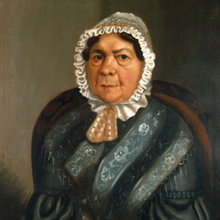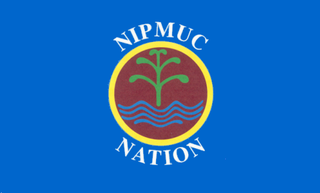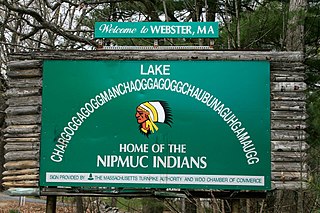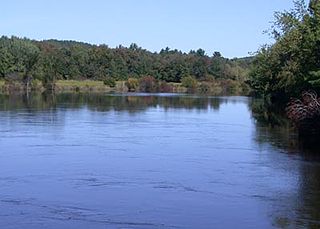
The Massachusett were a Native American tribe from the region in and around present-day Greater Boston in the Commonwealth of Massachusetts. The name comes from the Massachusett language term for "At the Great Hill," referring to the Blue Hills overlooking Boston Harbor from the south.
Praying Indian is a 17th-century term referring to Native Americans of New England, New York, Ontario, and Quebec who converted to Christianity either voluntarily or involuntarily. Many groups are referred to by the term, but it is more commonly used for tribes that were organized into villages. The villages were known as praying towns and were established by missionaries such as the Puritan leader John Eliot and Jesuit missionaries who established the St. Regis and Kahnawake and the missions among the Huron in western Ontario.

The Nipmuc or Nipmuck people are an Indigenous people of the Northeastern Woodlands, who historically spoke an Eastern Algonquian language. Their historic territory Nippenet, "the freshwater pond place," is in central Massachusetts and nearby parts of Connecticut and Rhode Island.

Praying towns were settlements established by English colonial governments in New England from 1646 to 1675 in an effort to convert local Native Americans to Christianity.

The Hassanamisco Nipmuc Band is the original state acknowledged Nipmuc tribe as stated in the 1976 Dukakis Executive Order, Section I. The Hassanamisco Nipmuc own three and a half acres of reservation land in what is present day Grafton, Massachusetts. This group of indigenous people is native to Central Massachusetts, Northeastern Connecticut, and parts of Rhode Island.

The Webster/Dudley Band of Chaubunagungamaug Nipmuck Indians, also known as the Chaubunagungamaug, Chaubunagungamaug Nipmuck, Pegan or Dudley Indians, are a Native American tribe indigenous to the U.S. states of Massachusetts and Connecticut in the region of New England. They are an unrecognized tribe, meaning they are not federally recognized as a Native American tribe. They are also not state-recognized, unlike the Nipmuc Nation.

The Chaubunagungamaug Reservation refers to the small parcel of land located in the town of Thompson, Connecticut, close to the border with the town of Webster, Massachusetts and within the bounds of Lake Chaubunagungamaug to the east and the French River to the west. The reservation is used by the descendants of the Nipmuck Indians of the previous reservation, c. 1682–1869, that existed in the same area, who now identify as the Webster/Dudley Band of the Chaubunagungamaug Nipmuck. Together with the Hassanamisco Nipmuc, both have received state recognition under the Massachusetts Commission on Indian Affairs.

The Nashaway were a tribe of Algonquian Indians inhabiting the upstream portions of the Nashua River valley in what is now the northern half of Worcester County, Massachusetts, mainly in the vicinity of Sterling, Lancaster and other towns near Mount Wachusett, as well as southern New Hampshire. The meaning of Nashaway is "river with a pebbled bottom".

Danyell "Daniel" Gookin was a Munster colonist, settler of Virginia and Massachusetts, and a writer on the subject of American Indians.
The Wabquisset was a praying town, that is, a settlement for Native American converts to Puritan Christianity, founded in the 1670s near present-day North Woodstock, Connecticut.
Matoonas was a sachem of the Nipmuc Indians in the middle of 17th century. He played a significant role in the Native American uprising known as King Philip's War.

The Lancaster Raid was the first in a series of five planned raids on English colonial towns during the winter of 1675-1676 as part of King Philip's War. Metacom, known by English colonists as King Philip, was a Wampanoag sachem who led and organized Wampanoag warriors during the war. Teaming up with Nipmuc and Narragansett warriors, the Wampanoag successfully raided the town of Lancaster, securing provisions and prisoners to help them carry on into their winter offensive.
The Massachusett dialects, as well as all the Southern New England Algonquian (SNEA) languages, could be dialects of a common SNEA language just as Danish, Swedish and Norwegian are mutually intelligible languages that essentially exist in a dialect continuum and three national standards. With the exception of Massachusett, which was adopted as the lingua franca of Christian Indian proselytes and survives in hundreds of manuscripts written by native speakers as well as several extensive missionary works and translations, most of the other SNEA languages are only known from fragmentary evidence, such as place names. Quinnipiac (Quiripey) is only attested in a rough translation of the Lord's Prayer and a bilingual catechism by the English missionary Abraham Pierson in 1658. Coweset is only attested in a handful of lexical items that bear clear dialectal variation after thorough linguistic review of Roger Williams' A Key into the Language of America and place names, but most of the languages are only known from local place names and passing mention of the Native peoples in local historical documents.
Peter Jethro was an early Native American (Nipmuc) scribe, translator, minister, land proprietor, and Praying Indian affiliated for a period with John Eliot in the praying town of Natick, Massachusetts.

Quashaamit was a bilingual Praying Indian sachem or sub-sachem, and teaching minister, possibly affiliated with the Nipmuc, (Massachusett) and Wampanoag tribes. Quashaamit worked closely with Massasoit, Metacomet, Wamsutta, and Wampatuck and deeded large tracts of land to early settlers in what is now Massachusetts and Rhode Island.

Daniel Takawambait was likely the first ordained Native American Christian pastor in North America, and served the church in the praying town of Natick, Massachusetts from 1683 to 1716. Takawambait also advocated for indigenous land rights in colonial Massachusetts, and authored at least one publication.
Black James was a Nipmuc constable and spiritual leader of the Chaubunagungamaug Nipmuck at the Chaubunagungamaug Reservation in colonial Massachusetts and Connecticut. Daniel Gookin appointed James to be a constable for the praying towns after he had become a Christian. In 1675, James signed a treaty agreeing not to assist King Philip, but may have supported him during King Philip's War. After the War, Black James deeded various parcels of land to settlers in Nipmuc country including at Quantisset and Maanexit in what is now eastern Connecticut near Rhode Island. His dying speech was recorded by Rev. Daniel Takawambait and later published and by 1686 a deed was signed by his heirs indicating that Black James was deceased, but another Indian used the name "Black James" until 1708.
Maanexit was a Nipmuc village on the Quinebaug River and Old Connecticut Path in Connecticut. The town was located near what is now Fabyan in Thompson, Connecticut and Woodstock, Connecticut. The name of the town means either "where the road lies" or "where we gather" which may have been "alluding to a settlement of Christian Indians in the immediate vicinity." The village became an Indian praying town through the influence of John Eliot and Daniel Gookin.

Quaiapen was a Narragansett-Niantic female sachem (saunkskwa) who was the last sachem captured or killed during King Philip’s War.
The Praying Indians of Natick were a community of Indigenous Christian converts, known as Praying Indians, in the town of Natick, Massachusetts, one of many Praying Towns. They were also known as Natick Indians.











